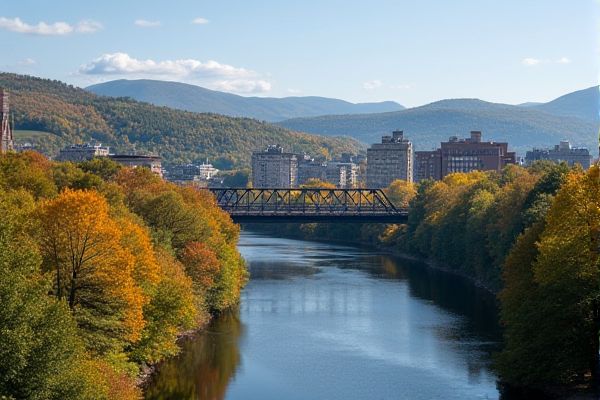
Weather and climate in Vermont: Cold winters with heavy snowfall. Mild, humid summers. Fall foliage season is spectacular. Spring can be rainy and unpredictable. Average winter temperatures below freezing. Summer temperatures range 60s-80sdegF. Lake Champlain moderates western weather. Microclimates affect local weather patterns. Frequent weather variations within regions. Ice storms can occur in winter.
Cold winters with heavy snowfall.
Vermont, despite its reputation for cold winters, is experiencing a shift towards more heavy, wet snow storms. This change is linked to climate change, which brings warmer winters and more extreme precipitation. As a result, the state encounters snow with higher water content that poses significant risks, causing damage to power lines and infrastructure. For more detailed insights into this phenomenon, you can explore the comprehensive analysis provided by Vermont Public. With these changes, Vermont's winter landscape is transforming, necessitating new adaptations and strategies to mitigate these challenges.
Mild, humid summers.
Summers in Vermont are warm and sunny, with average temperatures around 80°F (27°C), characterized by low humidity and a comfortable climate. This makes them ideal for outdoor activities like hiking, swimming, and camping. For more information about the state's seasonal conditions, consider exploring the Weather in Vermont from Hickok & Boardman.
Fall foliage season is spectacular.
Vermont's fall foliage season, typically from late September to mid-October, is spectacular due to the state's high concentration of maple trees and the gradual color change influenced by cooler temperatures and decreasing daylight hours. These conditions reveal vibrant red, orange, and yellow hues across the state's densely forested areas. For those planning a visit, the most crucial time to explore is during the peak of the season, when the landscape is a breathtaking canvas of autumn colors. Detailed information on the best times and regions to experience this natural wonder can be found on the official Vermont Vacation website, ensuring an unforgettable foliage journey.
Spring can be rainy and unpredictable.
Spring in Vermont is characterized by mild and quickly warming temperatures, but it can also be rainy and unpredictable, with increasing precipitation, particularly in May, and a higher frequency of heavy precipitation events. For a comprehensive understanding of these climatic changes, you can explore the insights provided in the Vermont Climate Assessment report, which details the evolving weather patterns in the region.
Average winter temperatures below freezing.
In Vermont, winter temperatures from December to February are typically between -10 to -20 degrees Celsius (14 to -4 degrees Fahrenheit), with nighttime temperatures almost always below freezing point. Winter in Vermont is long and cold, characterized by heavy snowfall and temperatures ranging from the single digits to the low 30s°F (-12 to 0°C). For more details on this and other states, visit the What's The Weather Like website.
Summer temperatures range 60s-80s°F.
In Vermont, summer temperatures typically range from the 60s to the 80s°F, with June and July being the warmest months. These months average maximum temperatures of 72°F in June and 78°F in July, with occasional peaks above 90°F (32°C). For more detailed information on Vermont's climate, visit the Seasons Year website.
Lake Champlain moderates western weather.
Lake Champlain moderates the weather in western Vermont by acting as a heat sink, slowing down the heating and cooling process, which extends the growing season and reduces heating degree days. This results in a longer growing season and lower heating costs compared to other parts of the state. For more details, visit the Lake Champlain Environmental Association website.
Microclimates affect local weather patterns.
Microclimates in Vermont are significantly influenced by factors such as elevation, slope, and proximity to water bodies like Lake Champlain and the Atlantic Ocean. These variations lead to three distinct climatological divisions: Western, Northeastern, and Southeastern. Each division experiences unique temperature and precipitation patterns due to the interaction of local topography and prevailing wind directions. For a deeper understanding of these climate variations, you can explore further details on the Climate Vermont website.
Frequent weather variations within regions.
Vermont's climate is characterized by significant regional variations due to factors such as elevation, terrain, and proximity to water bodies like Lake Champlain and the Atlantic Ocean. The state experiences a large range of diurnal and annual temperatures, with winter temperatures varying more than summer temperatures from one place to another, and frequent passage of low-pressure systems leading to abrupt changes in weather conditions. To learn more about these fascinating climate patterns, you can visit the Climate Vermont website.
Ice storms can occur in winter.
Ice storms in Vermont can occur in winter, characterized by significant ice accumulation from freezing rain, which can weigh down trees and power lines, cause power outages, and make roads extremely hazardous due to the weight and slippery conditions of the ice. These events often result from the combination of cold air from the Arctic and warm, moist air from the Gulf Coast, leading to severe impacts on infrastructure, economy, and daily life. For more information on how weather conditions like these affect the region, you can visit the Weather section of the Hickok & Boardman website.
